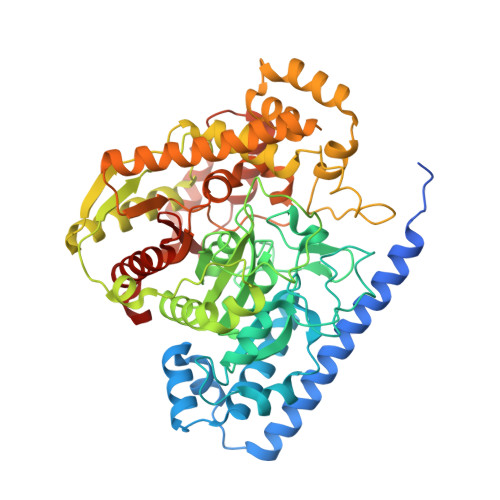Discovery and molecular basis of potent noncovalent inhibitors of fatty acid amide hydrolase (FAAH).
Min, X., Thibault, S.T., Porter, A.C., Gustin, D.J., Carlson, T.J., Xu, H., Lindstrom, M., Xu, G., Uyeda, C., Ma, Z., Li, Y., Kayser, F., Walker, N.P., Wang, Z.(2011) Proc Natl Acad Sci U S A 108: 7379-7384
- PubMed: 21502526
- DOI: https://doi.org/10.1073/pnas.1016167108
- Primary Citation of Related Structures:
3QJ8, 3QJ9, 3QKV - PubMed Abstract:
Fatty acid amide hydrolase (FAAH), an amidase-signature family member, is an integral membrane enzyme that degrades lipid amides including the endogenous cannabinoid anandamide and the sleep-inducing molecule oleamide. Both genetic knock out and pharmacological administration of FAAH inhibitors in rodent models result in analgesic, anxiolytic, and antiinflammatory phenotypes. Targeting FAAH activity, therefore, presents a promising new therapeutic strategy for the treatment of pain and other neurological-related or inflammatory disorders. Nearly all FAAH inhibitors known to date attain their binding potency through a reversible or irreversible covalent modification of the nucleophile Ser241 in the unusual Ser-Ser-Lys catalytic triad. Here, we report the discovery and mechanism of action of a series of ketobenzimidazoles as unique and potent noncovalent FAAH inhibitors. Compound 2, a representative of these ketobenzimidazoles, was designed from a series of ureas that were identified from high-throughput screening. While urea compound 1 is characterized as an irreversible covalent inhibitor, the cocrystal structure of FAAH complexed with compound 2 reveals that these ketobenzimidazoles, though containing a carbonyl moiety, do not covalently modify Ser241. These inhibitors achieve potent inhibition of FAAH activity primarily from shape complementarity to the active site and through numerous hydrophobic interactions. These noncovalent compounds exhibit excellent selectivity and good pharmacokinetic properties. The discovery of this distinctive class of inhibitors opens a new avenue for modulating FAAH activity through nonmechanism-based inhibition.
Organizational Affiliation:
Department of Molecular Structure, Amgen Inc, 1120 Veterans Boulevard, South San Francisco, CA 94080, USA.















